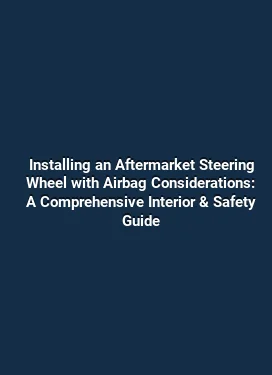How to Install Racing Harness: 4-Point vs 5-Point vs 6-Point
Choosing the Right Harness for Your Vehicle

Racing harnesses are a key component of interior safety for high-performance driving, track days, and competitive events. The decision between a 4-point, 5-point, or 6-point harness hinges on a combination of vehicle type, cockpit space, mounting options, and the level of restraint desired. A well-chosen harness can improve driver stability, reduce movement during aggressive cornering, and contribute to overall occupant safety when used in conjunction with a properly installed seat and seat belt system.
Before diving into installation, assess your cockpit layout, available mounting points, and the type of racing or performance activities you engage in. In street-use scenarios, a harness is often paired with a dedicated race seat and a properly engineered mounting system to ensure both comfort and safety. For competitive settings, regulatory or sanctioning body requirements may dictate the number of attachment points and the positions of anchors. Understanding these fundamentals helps guide the selection process and prevents retrofitting challenges later on.
Understanding Harness Configurations: 4-Point, 5-Point, and 6-Point
Understanding 4-Point, 5-Point, and 6-Point Harness Configurations

A 4-point system attaches the lap belt to two shoulder straps or a single shoulder strap plus two lap belts, forming a rectangle around the torso. This design prioritizes simplicity, quick release, and ease of installation, while still offering significant lateral support. A 5-point configuration adds a crotch strap, connected to the same buckle system as the shoulder and lap straps. The crotch strap helps prevent submarining, keeping the torso aligned during sudden deceleration or impact. A 6-point harness extends the setup with a second crotch strap or an additional shoulder strap, distributing loads more evenly across the upper body and reducing pressure on any single anchor. In high-G scenarios or cars with aggressive seating positions, the 6-point configuration can provide enhanced restraint while requiring careful mounting geometry to avoid interference with the seat or steering column.
Practical considerations include the seating position, harness routing, and the availability of compatible mounting points on the chassis. For older vehicles, the mounting points may need reinforcement, and the chosen configuration must align with the vehicle’s interior geometry to prevent belt twist or uncomfortable pressure points. A properly sized harness should sit flat against the torso, with the shoulder straps crossing at approximately the level of the shoulders and the lap belts positioned over the hips. The crotch strap should run to a securely anchored point below the seat to prevent forward movement of the torso during heavy braking.
Safety Considerations and Comfort
Helmets, head-and-neck restraint systems, and seat design all interplay with harness performance. The harness should be compatible with the seat material and bolster design, ensuring that straps do not chafe or slip under load. Padding at shoulder and hip contact points can improve comfort during long sessions, but it should not create obstruction for strap routing or buckle access. A harness that is too tight can impede breathing and circulation, while one that is too loose reduces effectiveness in a crash scenario. Regular checks for strap wear, frayed edges, and buckle integrity are essential as part of ongoing safety maintenance.
Another key factor is the mounting hardware. High-strength, properly rated hardware and correct anchor points are critical. Bolts must be securely fastened, with appropriate thread lockers where recommended by the manufacturer. If the vehicle’s structure or interior panels require changes or reinforcement, follow manufacturer guidelines or consult a professional installer. A well-planned installation minimizes belt movement, ensures even load distribution, and maintains occupant safety across a wide range of driving conditions.
Installation Steps: A Practical Guide
Preparation and Tools
Gather the right tools and parts before starting. You’ll typically need a set of metric and standard wrenches, a torque wrench, thread locker, a drill with appropriate drill bits if reinforcement is required, and a clean workspace. Inspect the harness kit for all components including webbing, buckles, shoulder pads, crotch straps, anchors, and any required brackets. Clear the seating area and remove debris that could snag straps during installation. Take measurements to ensure straps align with the mounting points and won’t cross the steering column, pedals, or other critical controls.
Plan the routing paths for each strap. For a 4-point setup, focus on clean lap belt and shoulder belt paths. For 5-point and 6-point configurations, determine crotch strap routing to avoid interference with seat rails or seat cushions. It is helpful to mock-route the belts without securing them to verify fitment and stitch lines, then proceed to permanent mounting once the path is confirmed.
Mounting Points and Anchor Bolts
Anchor points must be compatible with racing harness standards and rated for high loads. In most cases, lap belt anchors are mounted to the chassis or to reinforced seat belt mounting points. The shoulder belt anchors should align with the shoulder height and ensure the belt crosses the torso without rubbing against the neck or collarbone. If the vehicle lacks factory-grade harness mounting points, aftermarket brackets or a proper roll cage may be needed. Always follow the harness manufacturer’s torque specifications and bracket design to avoid prematurely stressed anchors.
When adding a crotch strap, choose an anchor point that prevents forward submarining without binding with the seat base or other hardware. If the seat is a fixed-back bucket seat, ensure there is clearance for seat rails and hardware. In some cases, replacing or modifying the seat mounting arrangement is necessary to maintain safety compliance and ergonomic comfort during vigorous driving conditions.
Threading Straps and Secure Buckles
Threading the straps correctly is essential for predictable restraint performance. The lap belts should pass through belt guides or slots designed to keep the strap flat across the hips. Shoulder belts should cross smoothly over the chest with minimal twisting. Buckles must be easily reachable and operate without obstruction. Some systems use a single, central buckle with multiple sub-belts, while others use separate buckles for each strap segment. If using a six-point system, verify that both crotch straps are connected to the same buckle assembly or to symmetrical anchors that allow balanced tension distribution.
After routing, perform a preliminary snug fit, then perform a series of simulated checks: sit in the seat, buckle up, and move the body to simulate typical driving loads. If any strap binds or causes discomfort, re-route or adjust anchor positions. Once you are satisfied with the fit, torque all mounting bolts to the manufacturer’s specification and replace thread lockers after final tightening. A careful final test in a controlled environment confirms that the belts remain taut and do not loosen under movement.
Vehicle Attachments, Compatibility, and Regulations
Not every vehicle is equally suited for every harness configuration. Some cars feature chassis structures or interior components that limit the number of viable mounting points. In modern race-ready vehicles, a four- or five-point harness is commonly used with a dedicated race seat and integrated mounting frames. Vehicles designed for circuit use may benefit from a six-point system when competition rules permit and when the driver seeks maximum upper-body restraint. Compliance with local regulations and event rules is important, as some sanctioning bodies specify acceptable configurations, mounting locations, and installation standards. When in doubt, consult with a professional installer who can assess the vehicle’s structure, confirm anchor strength, and ensure the restraint system aligns with the intended use.
Additionally, compatibility between the harness and other safety equipment matters. The presence of an HANS device, a helmet, and a snug seat contour can influence strap routing and tension. A harness should not interfere with helmet clearance or hinder the ability to operate the vehicle’s controls. A well-coordinated safety setup results in consistent performance across different driving scenarios and supports predictable occupant restraint during high-G maneuvers.
Maintenance, Inspection, and Longevity
Racing harnesses experience wear at stitching points, webbing, and buckles due to repeated loads, perspiration, and environmental exposure. Regular inspection should include checking for frayed webbings, cracked or damaged buckles, and corrosion on hardware. Clean the webbing with mild soap and water; avoid harsh solvents that may degrade the strap materials. Inspect the stitching around anchor points and ensure no thread is unraveling. If any sign of degradation is found, replace components or the entire assembly as needed to maintain structural integrity.
During vehicle storage, ensure the belts remain dry and away from direct sunlight to minimize UV-related degradation. When transporting or storing, avoid folding or crumpling the harness straps in ways that could create permanent creases or weak spots. Periodic professional inspections, especially after crashes or impacts, help verify that the system remains within design tolerances and continues to perform as intended during subsequent uses.
Practical Tips for Real-World Use
Marginal gains in restraint performance come from precise installation and disciplined usage. Always verify belt routing before every track session, and perform a quick fit check with the driver seated to ensure the harness remains properly positioned. For mixed-use vehicles that serve both street and track duties, consider a modular mounting approach that allows easy switching between harness configurations and the standard seat belt system when needed. Label or document anchor points to simplify maintenance and future upgrades, especially if multiple technicians may work on the vehicle over time.
Finally, align expectations with performance reality. A higher-point harness offers enhanced restraint but requires careful attention to fit, comfort, and vehicle integration. The goal is to achieve a secure, unobtrusive restraint that supports safe driving while allowing full control of the vehicle. With thoughtful planning, precise mounting, and regular maintenance, a racing harness contributes meaningfully to both safety and performance during demanding driving experiences.






